Choosing a cast iron manhole cover or a concrete one depends on what your project needs. You may need strong covers for busy roads. You might want a cheaper choice for places with less traffic. The material you pick changes safety, price, and how well the cover works. Cast iron is very strong and lasts a long time. It can hold heavy loads. Concrete looks good with its surroundings. It works well for places with less traffic. Brands like yytt give good options for many uses. They help you keep your roads safe and save money.
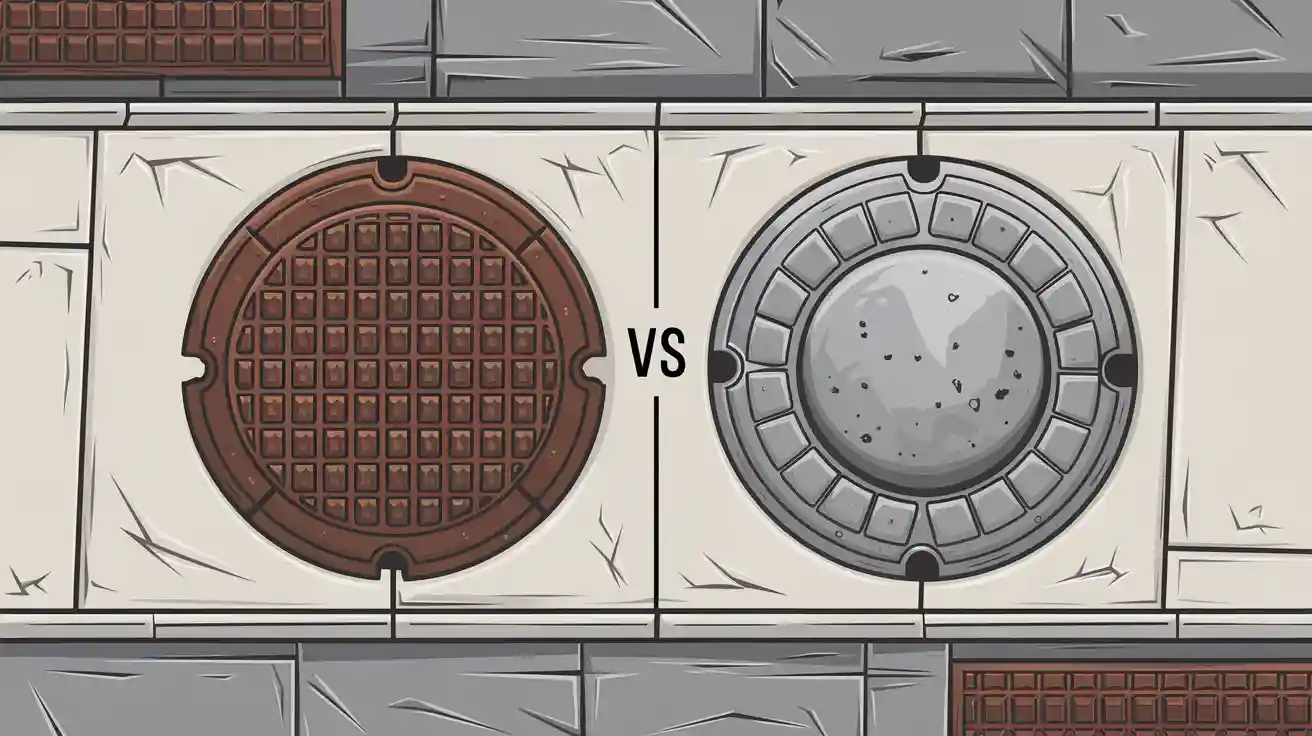
Key Takeaways
- Cast iron manhole covers are very strong. They last a long time. They can hold heavy weight. This makes them good for busy roads. They are also good for places with lots of cars.
- Concrete manhole covers cost less money. They work well in places with little traffic. Parks and sidewalks are good spots for them. But they do not last as long. They need more repairs over time.
- Security is important. Heavy or locked covers help stop theft. This is needed in busy or risky places. Cast iron covers can have special locks. These locks give extra safety.
- Picking the right cover depends on traffic, safety, and money. Always match the cover’s load class to the area. This gives the best results.
- Good installation and care save money. They also keep covers safe. Use the right tools for the job. Always follow safety rules with heavy covers.
Quick Comparison
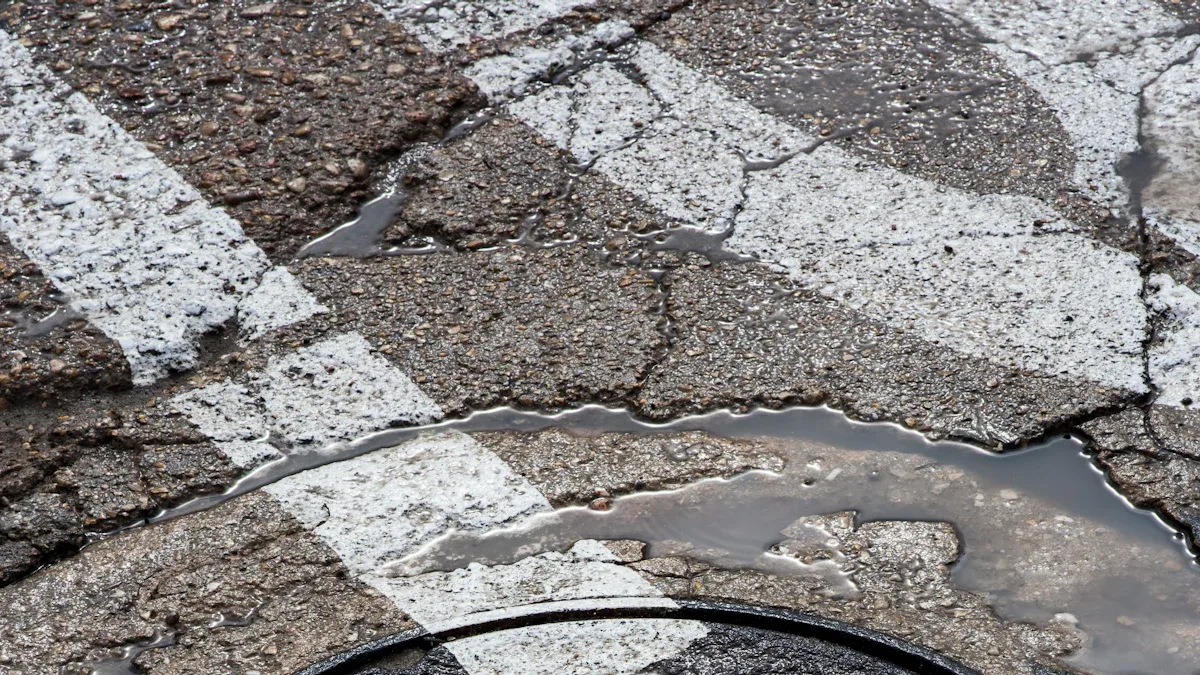
Main Differences
You might wonder how cast iron and concrete manhole covers are different. The table below shows how they compare in weight, lifespan, maintenance, and strength. This makes it easier to pick the right cover for your needs.
| Aspect | Cast Iron Manhole Covers | Concrete Manhole Covers |
|---|---|---|
| Weight | Lighter and easier to move, but can be stolen | Heavier and harder to move, not easy to steal |
| Lifespan | Lasts longer and stands up to bad weather | Does not last as long; can get damaged by rain |
| Maintenance | Needs special care and steps to stop theft | Needs more care because of weather; easy to make |
| Strength | Very strong and holds heavy loads | Strong, but gets weaker over time |
Tip: If you need a cover for a busy road or a place with lots of trucks, cast iron is a better choice. It lasts longer and can hold more weight. Concrete is good for places with less traffic and where you worry about theft.
Use Cases
Pick the right manhole cover for where you want to use it. Here are some common ways people use each type:
- Cast Iron Manhole Cover:
- Best for busy roads, highways, and places with lots of cars.
- Good for parking lots, sidewalks, and places that need to be strong.
- Used in city drains, sewage pipes, and to protect wires.
- Can hold very heavy things, from 2.5 to 90 tonnes.
- Has grip for safety and does not rust easily.
- Concrete Manhole Cover:
- Great for homes, sidewalks, and parks.
- Used on city streets, parking areas, and slow lanes with fewer cars.
- Costs less and is hard to steal because it is heavy.
- Comes in different types for different roads and green areas.
Each cover works best in certain places. Think about how much traffic, safety, and cost before you decide.
Iron Manhole Cover Durability
Cast Iron
Picking a cast iron manhole cover means you get something strong and long-lasting. Cast iron can handle heavy things and bad weather. Most cast iron covers last from 20 to 30 years. This is much longer than concrete covers.
| Material | Average Lifespan (Years) |
|---|---|
| Cast Iron | 20 to 30 |
| Concrete (RCC) | 10 to 15 |
Cast iron covers use tough materials like nodular (ductile) iron. This iron is very strong and can bend without breaking. It is hard to crack or break, even after many years. Nodular cast iron covers can hold loads up to 20 tons or more. They do not get damaged easily by cars and trucks driving over them.
| Property / Feature | Nodular (Ductile) Cast Iron Manhole Covers | Gray Cast Iron Manhole Covers |
|---|---|---|
| Typical Material | QT500-7 | HT200 |
| Tensile Strength (≥) | 420 MPa | Much lower |
| Yield Strength (≥) | 300 MPa | Much lower |
| Elongation (≥) | 7% (good plasticity) | 0% (brittle) |
| Impact Toughness | Similar to medium carbon steel, >10x gray iron | Low |
| Weight Comparison | About 30% lighter than gray cast iron covers | Heavier |
| Corrosion Resistance | High (service life 2x gray iron) | Lower |
| Fatigue Resistance | Implied superior due to toughness and elongation | Poor |
Trusted brands give you even more value. yytt makes cast iron manhole covers that follow strict rules like EN124 and ASTM. The company has ISO 9001 and other quality marks. You can trust these covers to work well on busy streets and highways.
Note: Cast iron covers do not wear down as fast as concrete. They need less fixing and do not need to be replaced often. This saves you time and money.
Concrete
Concrete manhole covers are a cheaper choice for many jobs. They work best in places with less traffic, like parks or sidewalks. Concrete covers last about 10 to 15 years. This is not as long as cast iron, but it is good for light use.
Concrete covers are strong against chemicals and rust. If you need a cover where there are lots of chemicals or salty water, concrete is a good pick. Concrete also does not let electricity pass through, which can make things safer.
But concrete covers are not as strong or tough as cast iron. They can wear out faster from rain, sewage, or heavy cars. You might need to fix or change them more often in busy places. Concrete covers are not as strong for their weight, so they cannot hold as much as iron covers.
If you need a manhole cover for a quiet street or park, concrete is a good low-cost choice. For busy roads or places with lots of trucks, cast iron is better.
Strength and Load
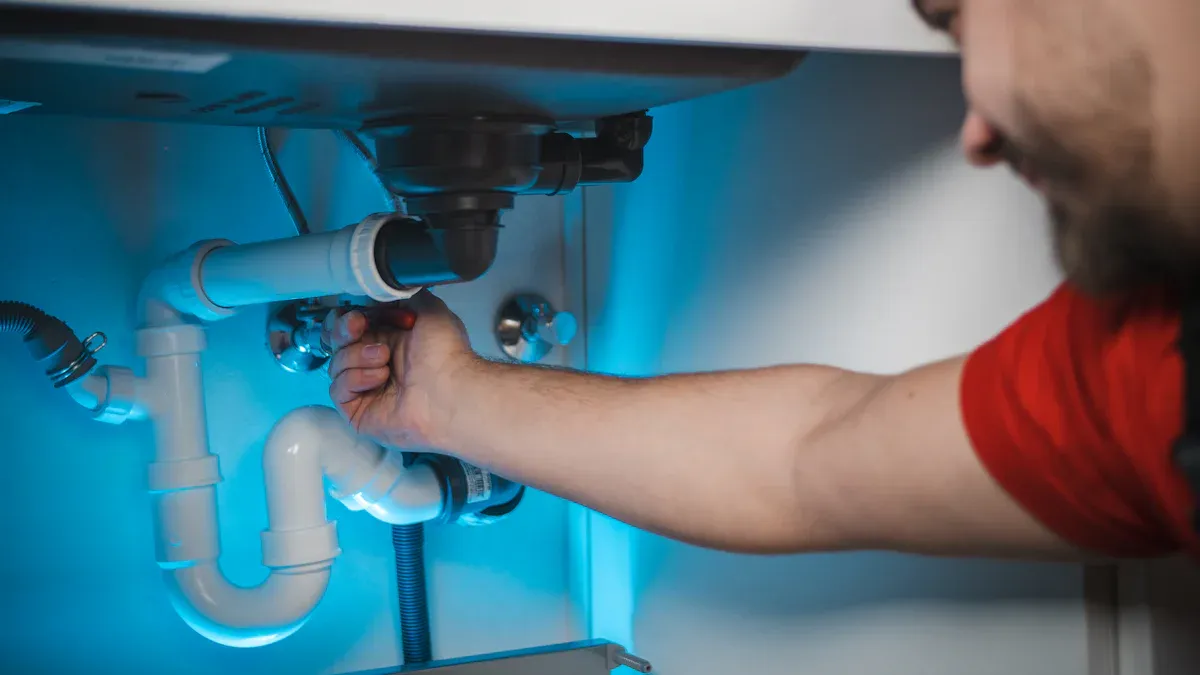
Heavy Traffic
If a road has lots of cars and trucks, you need a strong manhole cover. Cast iron covers, especially ductile iron, are very tough. They can hold heavy things without breaking or bending. You can use them on highways, busy streets, and places with big machines.
| Load Class | Load Capacity (tons) | Typical Application |
|---|---|---|
| D400 | Up to 40 | Roads, highways, heavy traffic areas |
| E600 | Up to 60 | Industrial zones |
| F900 | Up to 90 | Airports, heavy-duty sites |
Cast iron is the best choice for manhole covers. It is strong and lasts a long time. When coated, it does not rust easily. It can handle lots of cars and trucks. It does not crack or bend. This makes it safe and good for many years.
Concrete covers can be used in busy places, but they break more easily. Their edges are weaker than cast iron. If you want the safest cover for busy roads, pick an Iron Manhole Cover.
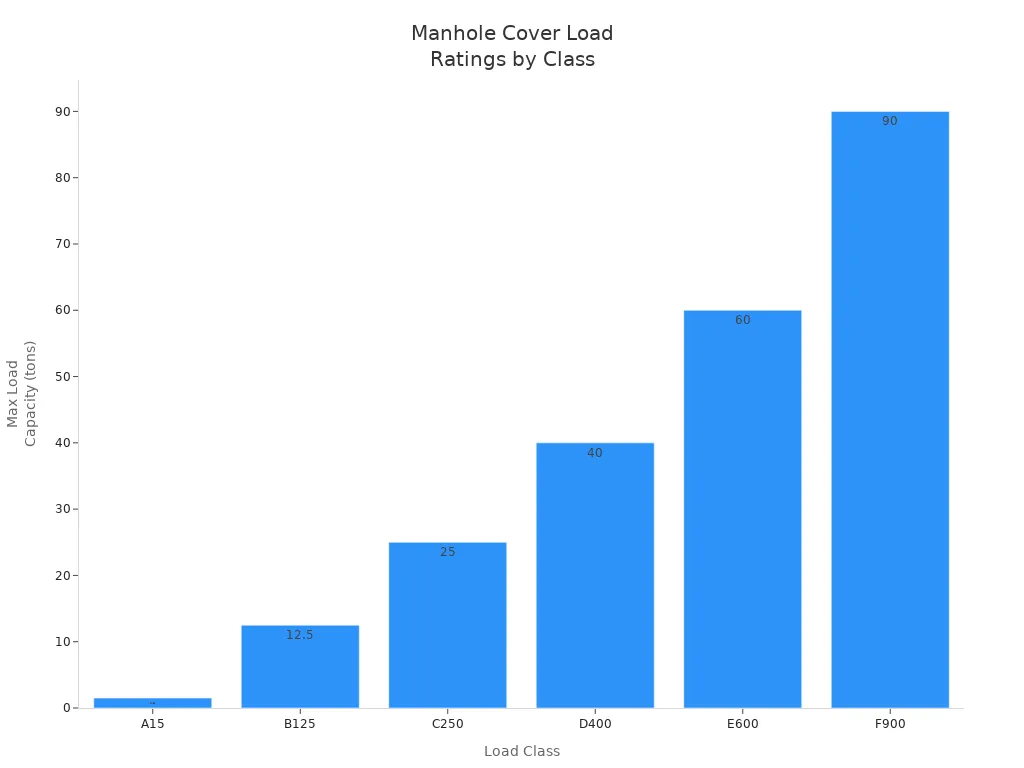
Light Traffic
Places with fewer cars, like parks or sidewalks, need less strong covers. Both cast iron and concrete covers work well here. You can use covers that are lighter and cost less money.
| Load Class | Load Capacity (lbs) | Typical Use/Application | Material Characteristics |
|---|---|---|---|
| A | 3,300 | Pedestrian use only | Suitable for light traffic; lighter load class |
| B | 27,500 | Cars, light trucks, slow lanes | Good for light traffic areas |
| C | 55,000 | Buses, garages, forklifts | Cast iron covers often rated here or above |
- Cast iron covers in classes A and B are good for parks and sidewalks.
- Concrete covers look nice and are used in walking areas.
- For places with no cars, concrete or fillable covers are common.
Always pick a cover that matches how much weight it needs to hold. For light traffic, you can save money and keep people safe by choosing the right type.
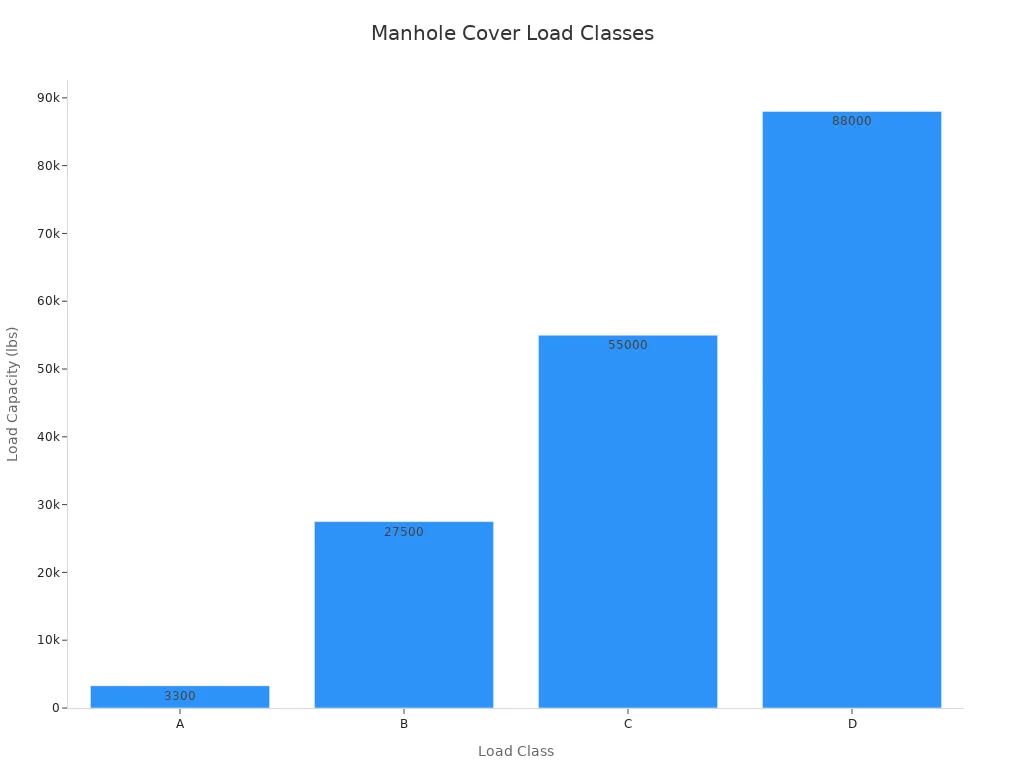
Cost Factors
Purchase Price
When you choose a manhole cover, price is often one of the first things you check. Both cast iron and concrete manhole covers can fit a wide range of budgets. You can find basic covers for as little as $20. Some high-end covers cost over $1,000. The price depends on the material, size, strength, and special features.
Here is a quick look at the price range for each type:
| Material Type | Price Range (USD per piece) | Minimum Order Quantity |
|---|---|---|
| Concrete Manhole Cover | $20.00 – $80.00 | 1 piece |
| Cast Iron Manhole Cover | $20.00 – $80.00 | 1 piece |
You may notice that entry-level cast iron covers usually cost between $50 and $150. Mid-range options go from $150 to $400. If you want a cover with extra strength or a custom design, the price can start at $400 and go much higher. The final cost depends on what you need for your project.
- Entry-level cast iron manhole covers: $50 to $150
- Mid-range cast iron manhole covers: $150 to $400
- High-end cast iron manhole covers: $400 and up
- Price changes with quality, size, and standards
Tip: Always check if the cover meets local safety rules. Covers that follow standards like EN124 or ASTM may cost more, but they offer better safety and durability.
Maintenance
You should also think about long-term costs. Maintenance can add up over time. Cast iron covers need less fixing because they resist wear and weather. You may only need to check them once in a while. This saves you money and time.
Concrete covers cost less at first, but they may need more repairs. Rain, chemicals, and heavy loads can damage them. You might have to replace them sooner, especially in busy areas. If you want to spend less on repairs, cast iron covers are a smart choice for roads and heavy-use spots.
Regular checks help you spot problems early. This keeps your covers safe and working well for years.
Security and Theft
Theft Risk
When picking a manhole cover, you should think about theft. Thieves often steal cast iron covers to sell the metal for cash. Some cities, like Bogota, Colombia, tried using concrete covers with less iron. But thieves still broke the concrete to get the iron inside. This means concrete covers with iron parts are not always safer. Lighter covers can also be easier for thieves to take.
In busy cities or crowded places, both cast iron and concrete covers can be stolen. Thieves want covers that are easy to move or have valuable metal. You can lower theft by choosing covers that are heavy or hard to remove. Covers with special locks also help.
Tip: Look at the area before you install a cover. If theft happens a lot, pick covers with extra security features.
Security Features
There are many ways to keep manhole covers safe. Companies make special features to stop theft and keep people out. Here are some common security options:
- Keyed padlocks let only people with the right key open the cover.
- Bolt down fasteners hold the cover tight so thieves cannot lift it.
- Tamper-resistant bolts need special tools to open, which makes stealing harder.
- Padlocks give more protection for important places.
- Independent locks fit under covers and stop people from getting in or dumping things.
- Stainless steel locks do not rust and last a long time outside.
- Some covers use a special key system and a non-slip top for safety in public places like schools.
- Locking devices can match other utility keys so workers can use them easily.
- Odor control and air test holes help keep the area clean and safe.
You can add these features quickly and they do not have parts that break easily. If you want to protect your Iron Manhole Cover or concrete cover, ask about these security options before you buy.
Note: Security features help stop theft and keep people safe by blocking unauthorized entry.
Design and Customization
Standard Options
There are many regular manhole cover designs to pick from. Cast iron covers give you more choices than concrete ones. You can get covers with names, logos, or different colors. These things help cities look special and neat. Cast iron covers also have patterns that help people not slip.
- Cast iron covers can have logos and colors you choose.
- You can pick patterns that help stop slipping.
- Cities use covers with names or logos to tell them apart.
Concrete manhole covers look simple and plain. They come in basic shapes and soft colors. These covers fit in well in parks and on sidewalks. There is not much you can change about how they look. Most concrete covers are made to work well and cost less.
If you want a cover that looks special or matches your city, cast iron is the better choice.
Custom Solutions
Sometimes you need a manhole cover for a special job. Custom covers let you pick the size, shape, and what it is made of. You can ask for covers made from cast iron, aluminum, stainless steel, or galvanized steel. Some custom covers can hold very heavy things, like at airports or ports. You can also get covers with coatings that stop chemicals from hurting them.
Custom concrete covers can be made for big holes or special shapes. You might need more than one piece for a large project. These covers can do more than regular concrete covers.
| Aspect | Standard Cast Iron Manhole Covers | Custom Cast Iron Manhole Covers |
|---|---|---|
| Material | Ductile Iron | Ductile, Aluminum, Stainless |
| Standard | EN124-2015, EN1433 | Project-specific |
| Price | USD 0.7 to 1.5 per kg | Higher due to custom features |
| Design Support | AutoCAD, PDF | Full engineering support |
| Load Capacities | EN124 A15 to C250 | Heavy-duty, aircraft-rated |
| Customization | Limited | Full customization |
Custom covers cost more money, but they work better and last longer. You can talk to brands like yytt to make a cover that fits your project just right.
Installation and Weight
Handling
You need to think about weight before you move a manhole cover. Cast iron covers often weigh between 90 and 400 pounds. Concrete covers can be just as heavy, depending on size and thickness. Heavy covers help keep roads safe because they do not move when cars drive over them. You must use special tools to lift these covers. Workers should never use basic tools like crowbars or pickaxes. These tools can hurt the cover and cause injuries.
Here are steps you should follow for safe handling:
- Remove dirt, mud, or ice from around the cover before lifting.
- Use manhole lifting devices that let you stand upright and avoid strain.
- Make sure your lifting tool can handle the cover’s weight.
- Lift the cover straight up, then move it safely to the side.
- Wear gloves and protective clothing to keep your hands and body safe.
- Get training on how to lift heavy covers without hurting your back.
- Use trench lid lifters for very heavy or odd-shaped covers.
Tip: Always check your tools before you start. Good tools make the job safer and faster.
Installation Process
You must follow safety steps when you install a manhole cover. Start by getting all the permits and making sure only trained workers do the job. Check the area for hazards like toxic gases or sharp objects. Put up warning signs and barriers so people know to stay away.
Here is a simple installation process:
- Clean the cover and the area around the manhole.
- Put on personal protective equipment (PPE) like gloves, helmets, and safety harnesses.
- Use lifting keys or mechanical equipment to move the cover into place.
- Make sure the cover fits tightly and does not wobble.
- Check that the cover meets the right load rating for the road or sidewalk.
- Test the cover by pressing down or tapping to see if it moves.
- Keep a first aid kit and rescue plan ready in case of emergencies.
The weight of the cover affects every step. Heavy covers need strong lifting tools and careful planning. Lighter covers are easier to move but may not be safe for busy roads. Standards like BS EN 124 help you pick the right cover for each job. If you choose an Iron Manhole Cover, you get extra strength and safety, but you must use proper equipment for installation.
Note: Always review safety rules and update your equipment to match the latest standards.
Environmental Impact
Sustainability
You may wonder how manhole covers affect nature. The material you pick matters a lot. Cast iron manhole covers need lots of energy to make. Foundries must melt iron at very high heat. This uses more fuel and makes more pollution than making concrete covers. Concrete covers use less energy to make. But they are very dense, so trucks use more fuel to move them.
Now, many makers use recycled iron for cast iron covers. This saves resources and helps the planet. New casting methods also make less waste and fewer mistakes. Some companies put special coatings on cast iron covers. These coatings help covers last longer and stop rust. You do not have to replace them as often.
You can see how cast iron and concrete compare in this table:
| Environmental Aspect | Cast Iron Manhole Covers | Concrete Manhole Covers |
|---|---|---|
| Production Energy | High (melting iron) | Lower than cast iron |
| Transportation Emissions | High (heavy weight) | High (dense material) |
| Lifespan | Long with coatings and recycled content | Good for light use |
| Disposal Impact | Often ends in landfill | Also ends in landfill |
Tip: Pick covers made with recycled materials and special coatings. This helps your project be better for the environment.
Recycling
You might ask what happens when a manhole cover gets old. Cast iron covers can be recycled. Foundries melt old covers and use the metal again. This saves new materials and cuts down on waste. Many makers now add recycled iron to their covers.
Concrete covers are harder to recycle. Most go to landfills because recycling concrete is not easy. Their heavy weight and mixed parts make it tough to recycle. Sometimes, old concrete covers get crushed for road base or fill. But this does not happen often.
Here is a table about density and recycling:
| Material | Density (g/cm³) | Recycling Potential |
|---|---|---|
| Cast Iron | ~7.3 | High; can be melted and reused |
| Concrete | ~2.4 | Low; usually ends up in landfill |
If you care about the planet, ask your supplier about recycled covers. Choosing recycled cast iron helps cut waste and protect nature. ♻️
Pros and Cons
Cast Iron
Picking a cast iron manhole cover gives you many good things. These covers are very strong and last a long time. Factories use careful steps and rules to make sure each cover is safe. You can choose from many styles, even special ones for your project. Cast iron covers do not rust easily, so they work well in bad weather. Companies also help you with good service and fast shipping.
- These covers are very strong and last for years.
- You can pick from lots of styles or get a custom one.
- Every cover follows important safety and industry rules.
- They last a long time and do not need much fixing.
- Sellers talk clearly and ship on time.
Here is a simple table that shows the main good and bad points:
| Advantages | Disadvantages |
|---|---|
| Very strong and lasts a long time | Costs more to make because of materials and how it is made |
| Does not rust easily | Heavy, so it is hard to move and carry |
| Follows safety rules | Competes with lighter covers |
| Needs little fixing | Can crack if hit very hard |
Tip: If you need a cover for a busy street or where trucks drive, cast iron is safe and strong.
Concrete
Concrete manhole covers have their own good points. Most covers make a dust and grit seal in about a year. This seal helps stop leaks and stays strong after cleaning. Only a few covers have leaks, and most are small. You do not have to worry much about water getting in. Concrete covers are easy to fix, so repairs cost less, but fixing many covers can cost more.
- About 80% of covers make a seal that stops leaks.
- Only a few covers leak, and most leaks are small.
- The seal forms fast and does not break when cleaned.
- Concrete covers are easy to reach and fix.
- Covers with synthetic fiber do not rust and are better for the planet.
- You can finish jobs faster and spend less money with these covers.
Note: Concrete covers are great for parks, sidewalks, and places with little traffic. They help you save money and are good for green building.
Recommendations
Heavy Load Areas
Places like highways, docks, and airports have lots of cars and trucks. These places need manhole covers that are very strong. Ductile iron and cast iron covers work best here. They last a long time and can hold heavy weight. You should always check the load class before picking a cover. D400 covers are good for busy roads. E600 and F900 are for places like docks and airports.
Here is a table to help you pick the right cover:
| Load Area Type | Minimum Load Class | Load Capacity (kN) | Material Recommendation |
|---|---|---|---|
| Carriageways of roads (heavy-duty) | D400 | 400 | Ductile iron preferred |
| Areas with high wheel loads (e.g., docks) | E600 | 600 | Higher grade ductile iron |
| Airports and very high wheel loads | F900 | 900 | Specialized heavy-duty materials |
| Kerbside installations | C250 | 250 | Suitable for moderate loads |
| Footways and pedestrian areas | B125 | 125 | Composite or reinforced materials |
| Areas inaccessible to motor vehicles | A15 | 15 | Lightweight materials acceptable |
Tip: Measure the opening and frame depth before you buy. This helps the cover fit right and stay safe.
You should also look for covers that do not slip and have strong locks. These features help stop accidents and keep the cover in place. Covers that meet EN 124 standards are safer and work better.
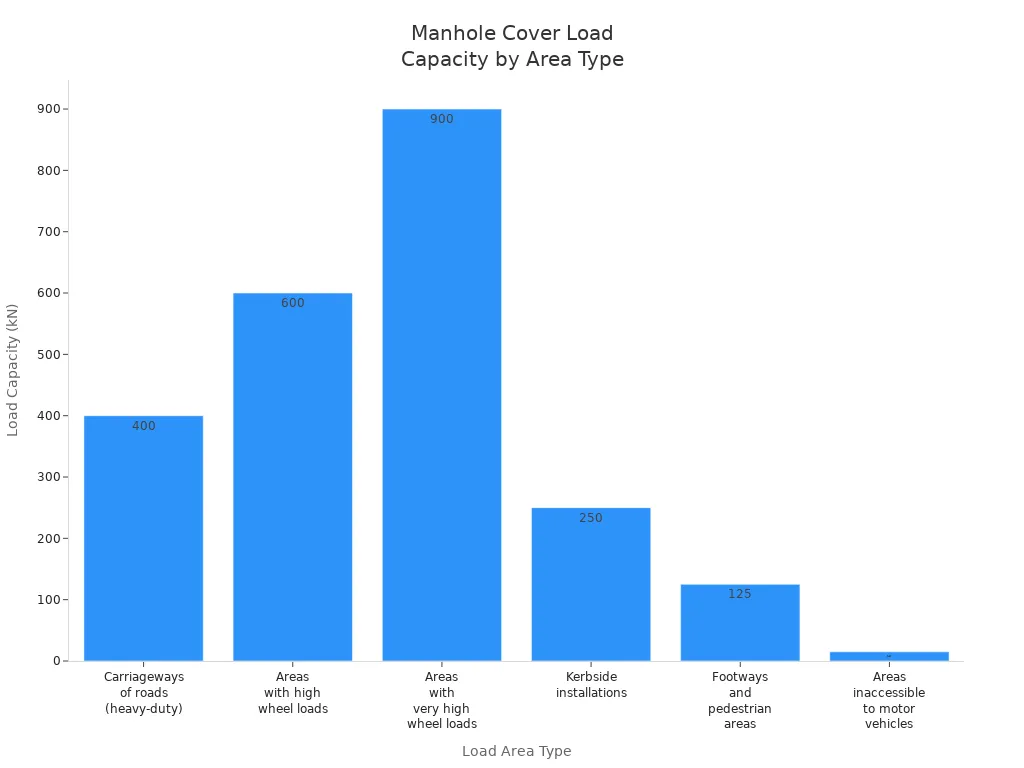
Budget Projects
If you want to save money, you still need to keep people safe. You can use plastic or basic concrete covers for parks and sidewalks. These covers cost less and are easy to put in. For places with more cars, you can pick covers made from polymer concrete or stainless steel. These covers last longer and are still not too expensive.
Here is a table to help you compare your choices:
| Cover Category | Typical Materials | Load Rating / Use Case | Cost Range (per unit) | Maintenance & Safety Notes |
|---|---|---|---|---|
| Entry-level | Plastic, Basic Concrete | Light-duty, pedestrian areas | $50 to $100 | Most cost-effective for budget-sensitive projects; suitable for low-load areas without compromising safety. |
| Mid-range | Polymer Concrete, Stainless Steel | Medium load classes | $100 to $300 | Balance cost and safety; better durability and load capacity than entry-level. |
| High-end | Cast Iron, Ductile Iron | Heavy-duty, industrial use | Over $300 | Highest strength and durability; ductile iron offers better corrosion resistance and longer lifespan. |
Note: Buying many covers at once can save you money. Always check for slip resistance and locks, even if you are on a budget.
Theft-Prone Locations
Some places have problems with people stealing manhole covers. You need covers with special locks and strong designs. Cast iron covers are hard to break and last a long time. You can add locks or bolts to make them even safer. These covers do not need to be replaced often, so you save money.
- Pick covers that are strong and hard to damage.
- Look for locks or bolts that stop people from taking the cover.
- Choose covers that can hold a lot of weight for busy places.
- Get covers that last a long time so you fix them less.
Concrete covers cost less and come in many shapes. But they break easier and do not last as long in busy or risky places. Cast iron covers give you better safety and protection.
Tip: In places where theft happens a lot, cast iron covers with locks are the best choice. They keep your area safe and you do not have to replace them often.
Picking between cast iron and concrete manhole covers depends on what you need. Cast iron covers are strong and last a long time. They are good for places with lots of cars and trucks. But they cost more money and are heavy to move. Concrete covers are cheaper and easier to put in place. They work well where there are not many cars. Look at the table below for a quick guide:
| Feature | Cast Iron Manhole Covers | Concrete Manhole Covers |
|---|---|---|
| Durability | Excellent | Good |
| Load Capacity | Heavy traffic | Light traffic |
| Cost | Higher | Lower |
| Theft Risk | Higher | Lower |
Think about what your project needs most. If you have a busy road, choose an Iron Manhole Cover from a trusted brand like yytt. For parks or sidewalks, concrete covers might be better. If you want more info or a price, you can ask yytt for help.
FAQ
What is the main difference between cast iron and concrete manhole covers?
Cast iron covers last longer and hold more weight. Concrete covers cost less and work well in places with little traffic. You should pick the one that fits your project needs best.
How do I know which load class I need?
Check how many cars or trucks will drive over the cover. For busy roads, pick D400 or higher. For sidewalks or parks, A15 or B125 is enough. Always match the load class to the area’s use.
Can I get a custom manhole cover with my city’s logo?
Yes! Many brands, including yytt, offer custom designs. You can add logos, colors, or special patterns. Custom covers help your city stand out and improve safety.
Are cast iron manhole covers safe from rust?
Modern cast iron covers use coatings that stop rust. You get a cover that lasts longer and stays strong, even in bad weather. Always ask your supplier about rust protection.
How do I order a manhole cover from yytt?
You can contact yytt by leaving your email address. The team will reply within 24 hours. They help you choose the right cover and send you a price list.
Post time: Aug-22-2025
